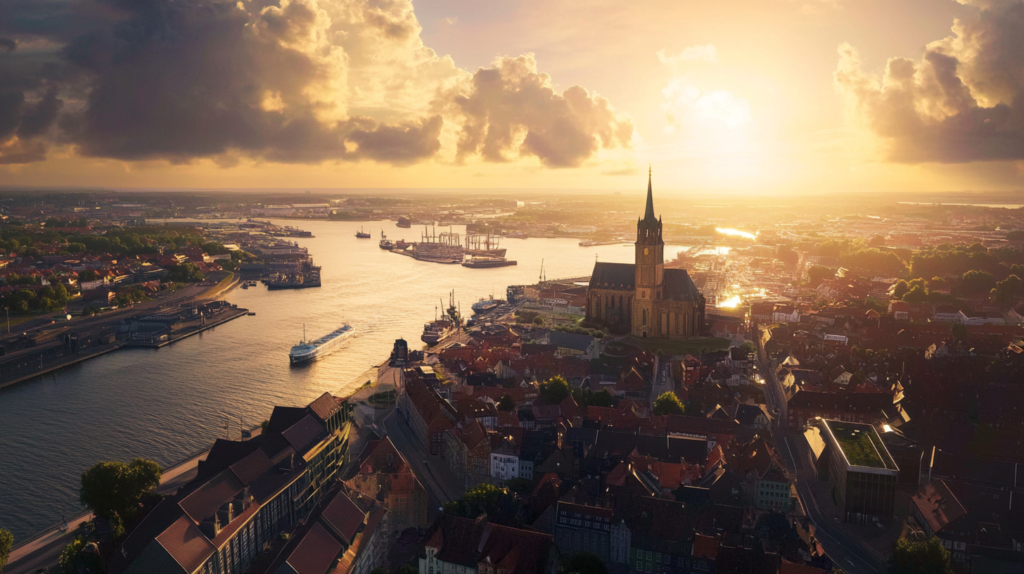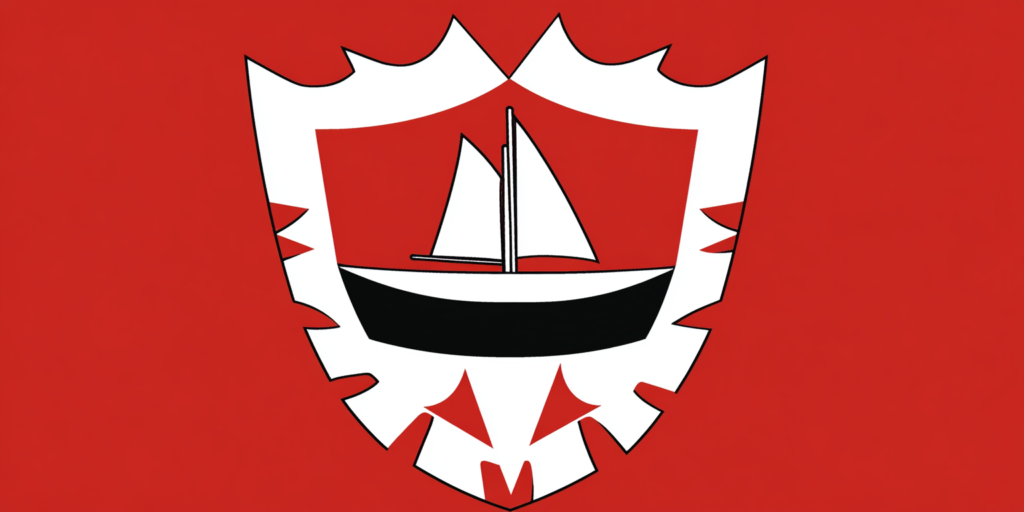
Kiel, the dynamic capital of Schleswig-Holstein in northern Germany, features a captivating blend of history, maritime energy, and engineering feats.
Its historic city center, largely rebuilt after World War II, retains a charming atmosphere with elegant squares, lively shopping streets, and notable landmarks. These landmarks include the Kiel Rathaus (city hall) and the striking St. Nikolai Church.
Kiel’s harbor is a major ferry port and a hub for sailing enthusiasts. The Kieler Woche, an annual sailing regatta, attracts global visitors, filling the harbor with colorful sails and maritime excitement. Kiel’s maritime importance extends beyond its harbor.
The city houses the entry/exit point of the Kiel Canal (Kieler Kanal) on the Baltic sea side. The canal is a true engineering marvel connecting the North Sea to the Baltic Sea. This 98-kilometer canal, known as the “most frequented artificial waterway in the world,” facilitates international trade and offers stunning views of passing ships and picturesque landscapes.
Visitors to Kiel are captivated by its unique blend of maritime heritage and modern dynamism, whether exploring the historic streets, enjoying the vibrant harbor, or marveling at the Kiel Canal.

Description of the Kiel Coat of Arms:
- The coat of arms features a silver Holstein nettle leaf (Nesselblatt) on a red background, with a black, masonry-style boat placed on top of the nettle leaf.
- The design was officially granted on May 14, 1901, by Kaiser Wilhelm II.
Historical Significance:
- Nettle Leaf (Nesselblatt):
- The nettle leaf is the symbol of the Counts of Holstein, who were the historical rulers of the region. It has been a part of Kiel’s heraldry since the city’s earliest seals.
- It represents the city’s connection to the Holstein region and its historical governance under the Schauenburger counts.
- The Boat:
- The boat symbolizes Kiel’s long-standing relationship with seafaring and trade. Kiel, located on a fjord (the Kieler Förde), has always been closely tied to maritime activities.
- The boat also reflects the city’s prosperity as a trading and Hanseatic city during the 14th and 15th centuries.
- In the modern era, Kiel became a major naval base (Reichskriegshafen) after 1871, further cementing its maritime importance.
Evolution of the Coat of Arms:
- The earliest seals of Kiel (from the 13th century) show a ship with a helmsman, two stars, and the nettle leaf shield at the bow.
- By the 14th century, the design evolved to something closer to the modern coat of arms, with the nettle leaf and ship combined.
- In the 16th century, the nettle leaf was depicted floating above the ship in the city’s seals.
- The current design, with the boat placed directly on the nettle leaf, was officially established in 1901 by the Prussian Heraldic Office and has remained unchanged since then.
Symbolism of the Boat:
- The boat is a masonry-style (gemauertes) boat, which is unique and symbolizes the city’s strength and permanence.
- It also reflects Kiel’s role as a maritime hub, both historically and in modern times, with its shipbuilding industry and ferry connections.
Historical Context of Kiel:
- Kiel was founded in 1242 by Count Adolf IV of Schauenburg and was granted city rights.
- The city’s name, “Kyl”, derives from the Kieler Förde (Kiel Fjord), meaning “wedge” or “narrow bay,” reflecting its geographical location.
- Kiel became a residence city for the Holstein counts in the 13th century and later served as a seat of power for the Dukes of Gottorp in the 18th century.
- After World War II, despite significant war damage, Kiel became the capital of the newly founded state of Schleswig-Holstein.
Modern Significance:
- Today, Kiel is known for its shipbuilding industry, naval base, and as a major ferry port connecting Germany to Scandinavia.
- The coat of arms continues to symbolize Kiel’s maritime heritage, its historical roots in the Holstein region, and its role as a political and economic center.
Summary of Key Elements:
Red and Silver Colors: Reflect the traditional colors of Holstein and Schleswig.
Nettle Leaf: Represents the Holstein region and the historical rule of the Schauenburger counts.
Boat: Symbolizes Kiel’s maritime tradition, trade, and naval importance.
Top 3 Kiel
- Kiellinie Promenade
- This waterfront stretch along the Kiel Fjord is the city’s heartbeat. It’s about 3.5 kilometers of scenic strolling, with views of massive ships, yachts, and the occasional cruise liner gliding in. You’ve got cafes and benches to soak it in, plus it’s lively during events like Kieler Woche (the world’s biggest sailing regatta in June). It’s free, accessible, and gives you Kiel’s nautical essence without breaking a sweat.
- Laboe Naval Memorial & U-995 Submarine
- Just 15 kilometers northeast of downtown (a quick bus ride on the 100 or 102), this duo is a must. The 72-meter tower honors sailors lost at sea, with an observation deck offering killer views over the fjord—elevators or 341 steps, your call. Next door, climb inside U-995, a real WWII German sub turned museum. It’s cramped, eerie, and a history buff’s dream. Combo tickets are around €11, and it’s open daily.
- Botanic Gardens Kiel
- Tucked near the university, this spot’s a green oasis with over 3,000 plant species across themed gardens and greenhouses. It’s free to wander the outdoor areas, with a small fee (€2–3) for the exotic indoor sections. Think colorful blooms, peaceful paths, and a break from Kiel’s urban hum—perfect for a chill afternoon or some blog-worthy photos.
Bonus Tip: An of the Beaten Path Location
- Kiel Canal Viewing Point at Holtenau
- A short trip north of the city center (bus or a 15-minute drive), this spot lets you watch ships navigate the world’s busiest artificial waterway. The locks at Holtenau are hypnotic—giant freighters and ferries squeezing through, sometimes just meters apart. There’s a small museum too, but the real draw is grabbing a coffee and marveling at the engineering. It’s low-key, free, and pure Schleswig-Holstein.